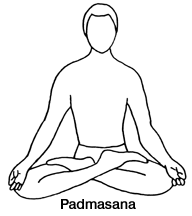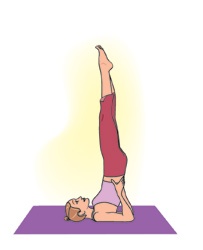Hatha Yoga is good for you but not by osmosis. It takes a long time to develop the practice and more advanced poses should be approach slowly and carefully.
Numerous advanced hatha yoga poses are not given their due respect.
The three hatha yoga poses that I do but no longer teach are lotus, headstand, and shoulder stand.
These three poses are more complicated than most people realize and though they are each beneficial for different reasons, over the years, to make my teaching life easier I have stopped teaching them.
Three Hatha Yoga Poses I Do But No Longer Teach
Lotus
Lotus is one of my favorite shapes.
I have been doing it since I was a little boy.
My brother and I, both very open in the hips used to wrestle in lotus, whatever that means. But my mother loved to tell me all about it.
If you are open in the hips like I am lotus is most likely not going to be a problem unless you are careless about how you get into it.
But with attention, anyone with accommodating hip sockets should be able to achieve lotus, and feel free to do it. For me it’s comfortable.
The main reason that I don’t teach it is that getting the second leg into the pose isn’t particularly pretty, even for the most open-hipped among us.
The first leg is a breeze. Technically I draw my heel as close to my pelvis as possible fully flexing the leg.
With the upper and lower leg touching the knee joint is balanced and I can rotate that leg into half lotus without putting any torque on the ligaments of that right knee.
I am not saying that anyone can do that but a great many students can get that far.
All bets are off when it comes to bringing the second leg across the first.
While I can hinge my knee in a somewhat similar fashion the rotation in the hip socket is very different.
It is extremely difficult to get that second foot over the shin that is in half lotus without putting some torque in the knee of the second leg.
Why I can do this with little problem is that I have fairly loose ligaments to go along with my loose joints.
This usually goes hand in hand. So even though I am torqueing the ligaments of my knee they can take the strain and once I am in the full pose I can find a more balanced environment for these ligaments.
Students with tight hips often have tight ligaments as well and even if they don’t, the lack of rotation that comes from the hip will require too much stress and strain on the ligaments of their knees.
Headstand
For whatever reason, of the four major inversions—headstand, shoulderstand, handstand and forearm stand—students are very willing to throw themselves into both headstand and shoulderstand even though they are far more complex than the other two.
Anyone who does headstand and shoulder stand needs to have a good deal of core strength and an awareness of their own spine.
Scoliosis is not necessarily a reason to avoid this hatha yoga the pose if you are aware of your scoliosis and have the strength to support it.
Disc issues such as herniation and spondylosis are a pretty good reason to avoid both head and shoulder stand (though again awareness and a solid core can balance out my suggestion not to do them)
I teach handstand a lot because I think it is fairly safe to try and not accomplish.
You hop up and down and if you don’t make it up, no worries.
It is always bemusing to see a student who can’t do handstand try to do headstands instead—invariably without asking me if that is all right.
Most often these rogue practitioners set up with the elbows too wide and their head in the wrong place and try to jump up into a pose that it way more dangerous too attempt than handstand—at least from my perspective.
Personally, I love headstands. I don’t do them for ten minutes at a time like I used to, and I am sure it would be a struggle these days to stay up for five but I still have the strength to do them without difficulty.
I am not opposed to teaching someone to do headstand; I just choose not to offer them in group classes because I can’t truly be aware of what everyone is doing.
If I do teach the pose my rule is that you have to be able to go up in slow motion.
The standard way I approach this, which goes to when I first started doing them, is to set up with the upper arms as close to parallel as possible and the crown of the head on the floor.
When the feet walk in one leg should bend with that heel lifting up to the base of the pelvis. The second foot should come up to meet it with very little effort and a fully straight spine. If the neck rounds towards the clasped fingers to accomplish this there isn’t enough strength to do the pose.
After both knees are bent with feet up near the pelvis the legs then extend up straight.
If someone can’t do this slowly, with control and a strong straight spine, they have no business doing headstand because they lack the core tone to alleviate pressure from the neck.
Shoulderstand
Oh how I love shoulderstand.
And plough before shoulder stand opens my back in a beautiful way.
I love to do them first thing in the morning though they might not be a thing of beauty at that time.
Amazingly I find that people will throw themselves into shoulderstand with even more abandon than headstand and for the life of my I can’t understand why.
Putting the head and neck at a ninety degree angle to the rest of the spine is some serious business that shouldn’t be taken lightly.
Again it is an issue of core tone. While I want practitioners to go into headstand in slow motion, someone needs to be pretty advanced to get into shoulderstand in the same slow fashion.
Unfortunately even seasoned students often hurl themselves over into plough before coming unsteadily into shoulder stand often rocking quite a bit from side to side on the neck to find the placement of the hands.
And when it comes to shoulders in a similar way to the open hips required of lotus, you need a lot of rotation in the shoulders to get the hands in a suitable place to support the back when upside down in shoulderstand.
Without the proper hand placement it is very hard to get the spine to lengthen up enough to align the body correctly.
Shoulderstand has particularly good benefits for thyroid issues but they are contraindicated if someone can’t elevate the spine correctly into the correct depth of the pose.
The same spinal issues that I mentioned in headstand apply even more seriously to shoulderstand. Students with any instability or other issues in the cervical vertebrae would be best to avoid this pose.
Does this mean that they should never do them? Maybe and maybe not, but teaching in a group environment I can’t know what is going in with every student and I have to acknowledge that they often aren’t aware of what is going on in their own bodies, or always know what is best for them in a hatha yoga class.
I don’t do these three poses every day but I never hesitate to add them to my practice.
But for the above reasons I rarely teach them. I have seen first-hand how students can get hurt trying to get into complicated shapes that might be best left for more advanced practitioners.
To me it is simply not worth the risk to put someone’s knees, hips and spine in harm’s way.
***



